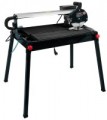Power
Rated motor power of the electric tile cutter. The more powerful the engine — the more force it can give to the cutting tool, the higher the rotation speed and disc diameter can be. Accordingly, a more
powerful tool is better suited for larger jobs and hard and/or thick materials. On the other hand, high power significantly affects the price, dimensions and weight of the tool, despite the fact that there is not always a real need for it.
In light of all this, it is necessary to choose a tile cutter in terms of power, taking into account the specifics of the intended use. So, in the case of a hand tool for simple household work, a power of 700 – 800 W is enough, more solid indicators may be required mainly for professional use. But in stationary units, where compactness does not really matter, you can not save on power — especially since such devices are usually used where performance is important.
Cutting length
The longest cut that can be made with a tile cutter.
This parameter is relevant primarily for manual tile cutters, as well as for electric stationary units with a top disc feed. In such tools, the cutting element moves along the guide rail and has limited space for movement, and the length of the cut is, in fact, the length of the stroke of the cutting tool from one extreme point to the other. In fact, this is the maximum width of the material that can be cut with a tile cutter.
Cutting depth
The greatest depth to which the tool can cut through the material being processed, in other words, the maximum thickness of the tile that the tile cutter is guaranteed to be able to cut.
It is worth choosing a tool for this parameter taking into account the thickness of the material with which to work, plus some margin “just in case”. But this margin should not be too large: for a
deep cut, large discs and high power are required, which accordingly affects the price, weight and dimensions of the tool.
Water cooling
The presence in the design of the electric tile cutter
of a system for supplying water to the disc.
Water supplied directly to the cutting point plays several roles: it cools the cutter and tile, reduces friction at the point of contact, and also precipitates the dust generated during operation. This reduces the risk of cracks and chips, provides a neat and even cut, allows you to cut thin strips of material, and also has a positive effect on the life of the blade and the entire tool. The supply of water, usually, is in its own tank installed on the tile cutter.
Disc/cutter feed
This parameter describes from which side the disk or cutter of the tile cutter is fed to the tile.
- Upper. The top position of the cutter is standard for manual as well as portable electric tile cutters (see "Type"). Stationary electrical units with this arrangement are more bulky than the "lower" ones, and have restrictions on the length of the cut. On the other hand, they are more convenient and accurate.
- Lower.
The bottom feed of the disc is found exclusively in stationary electric tile cutters. The design of such a tool resembles a classic circular saw: it has a tabletop, from which the edge of the cutting disc protrudes. Such units are considered less accurate than top feed models, but they are more compact, and the length of the cut is limited only by overheating of the disk.
Folding table legs
The presence of
folding legs at the table on which the electric stationary tile cutter is installed (see "Type"). This feature allows you to significantly reduce the dimensions of the structure for ease of storage or transportation.
Table dimensions
The size of the working surface of the stationary tile cutter (see "Type"). The larger the table, the lower the likelihood that the tiles will hang from it during operation.

